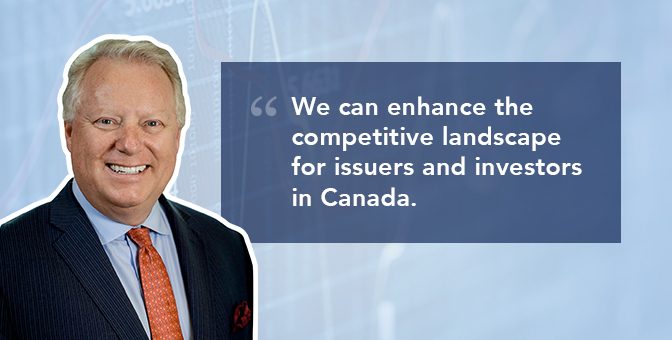Earlier this month, CSE CEO Richard Carleton sat down for an interview to recap an eventful 2021 and what is shaping up to be the CSE’s biggest year ever in 2022.
It is fair to say that the CSE is moving to a new level in the global exchange ecosystem – it’s like the next generation of the CSE. A senior issuer designation is part of this evolution. Can you update us on its status and the importance of the new designation, both to CSE issuers and the Exchange itself?
I think I should start by explaining that there is no such thing as an exchange designation being senior or junior. The way securities regulation works in Canada is that it is the companies that are characterized as being senior or venture issuers.
On December 9, we formally announced a project in the form of a request for comment published by the BC and Ontario securities commissions. What this entails is a significant rewrite to the listings rules of the Canadian Securities Exchange.
There are two major facets to the project. The first one is that we are updating our requirements for junior companies, both at the entry level and to continue to be listed on the Exchange. We have worked with our regulators over the last couple of years to revise these rules.
The second part, which is grabbing all of the headlines, is that we are creating a senior tier of the exchange. This is not a new exchange or separate trading facility, but a designation for a certain number of our issuers who have achieved a certain size and maturity in terms of the development of their business. Do they have revenue? Do they have significant assets? Is their sales trajectory rising? Do they have a significant market capitalization?
We’ve identified some 60 to 80 companies that would qualify to list on similar exchanges in Canada, and we’ve also seen a move by companies to dually list with Nasdaq this year. So, we are creating a rule framework that will regulate these companies, in effect as senior issuers.
The new framework will require these companies to have larger boards, bring more prescription around corporate governance procedures, plus set shorter timeframes to complete quarterly and audited annual financial reporting. There are also a few other measures that the companies will have to abide by, including more supervision of their continuous disclosure to the market.
In return, we believe there are multiple benefits for issuers designated as members of the senior tier. The first is that we have been working with IIROC to ensure these companies will be included on IIROC’s list of securities that are eligible for reduced margin when in dealer inventory. Right now, when dealers are holding CSE issuers in inventory, they have to take a charge against their regulatory capital of 100 cents on the dollar. Companies trading at more than $5.00 per share will only have to have a charge against regulatory capital of 20 cents, which is equivalent to that on other exchanges in Canada that serve as a senior company marketplace. It sounds technical, but it will have a practical impact on reducing the cost of capital for these companies when they are raising money.
We’re also working with international index providers to ensure that these companies are eligible for inclusion in different indices. For example, the US multi-state operators, which in many cases have market capitalizations in the billions of dollars, could qualify for inclusion in one of the MSCI or FTSE US indices. We have companies operating in Israel that would qualify for inclusion in the Israeli indices. We have been working with the index companies to provide for this capability.
We’ll also have, as part of the senior designation, the ability to list SPACs (Special Purpose Acquisition Companies), exchange traded funds, and structured products. And that’s important because we know that there are a number of ETF manufacturers that would like to launch products that are US cannabis-oriented, and they could launch those products on the CSE. There may not be much room left to run in the SPAC space, but we also know that there are some interesting structured products that are being developed, and we think we are the logical home for those instruments.
That is all part of the Exchange competition to come, where we will be working with the creators of these products to provide an appropriate home for their new listings.
Read Richard’s latest blog post here to learn more about issuer designations and the request for comments on the CSE’s proposal to revise its listing policies.
The senior designation is obviously going to be a very important development. Considering this, the impressive financing activity, the consistent growth in both institutional and retail investor participation, and other factors we have discussed, can you talk to us more about your views on the CSE’s evolving position within the broader global financial marketplace.
It is very much an evolution. We have been at this for 20 years and have the benefit of a very experienced team, whether it’s on the trading, market information, or listings regulation side, who understand at a very deep level what it takes to provide successful exchange services to the issuer, investor, and trading communities.
What it has really been is a series of efforts by us to eliminate all of the barriers and friction points for our issuers in the provision of those services. If I think back some years ago, we weren’t accessible by the online discount brokers in Canada. That was a huge issue that we devoted a great deal of time and energy to, and then five or six years ago, we managed to overcome that hurdle. Of course, that had a big impact on turnover, accessibility, and the appeal of a listing on the Canadian Securities Exchange.
Now that we have a cohort of larger, highly successful companies that have achieved a significant level of development in their lifecycle, we are looking at the friction points there. I talked about membership in international indices. We also need to improve access for international investors, one example being brokers who provide access to Canada for accounts in Europe, Asia, the Middle East, and other regions. We have to ensure they have access to these names.
There are institutional investors who claim they won’t invest in the small-cap space and have concluded that anything listed on the CSE is small-cap in nature. We have to work with these institutional investors to educate them about the success that many of our issuers have had, and the fact that they have attained market capitalizations in excess of a billion dollars in a number of cases.
At the end of the day, it’s a case of keeping our nose to the grindstone. It’s doing the hard work, making the trips, representing the issuers, identifying the hurdles, and developing plans to overcome those challenges.
It really sounds like 2022 is going to be one of the most important years in the CSE’s history. Let’s conclude with your thoughts on what companies listed on the CSE can anticipate in terms of service enhancements in the new year.
In the first part of the year, we are going to be working with the industry on completing the comment period for the new listings manual project. And in conjunction with that, we are going to be quite vocal across a variety of channels, explaining to people that we have succeeded with a number of very large companies, so the marketplace can expect some promotion and information related to that.
As our customer base grows and our regulatory obligations and connection with the framework for the senior issuers grows, we will be enhancing the teams who work with our issuers and their advisors, in our Toronto and Vancouver offices in particular. It is incredibly important that we continue to maintain our service levels, which is a really important part of what we do. I have received tremendous feedback over the years regarding both the personal service levels people feel they get at the Canadian Securities Exchange and the very positive problem-solving culture within our group. And we are certainly looking to maintain that as we continue to build out the team in order to provide high levels of service.
And I know we have talked about it for some years now, but we will see settlement and clearing services from the Canadian Securities Exchange in 2022. In fact, I have just come from a demonstration of the real, live system which is up and running in our testing environment. So, that is something I think will give us a significant advantage, in particular when we are working with the industry on listing structured products and taking advantage of the benefits of tokenizing their securities.
Obviously, there is lots going on. As we know, there is also motion in the global securities world. We’ve got Cboe Global Markets, which has acquired the NEO Exchange locally, and they will be closing that transaction at some point next year. And so that really leaves us as the only Canadian listing venue, along with the TMX Group, being locally owned and operated. That is an advantage we will be continuing to present to the industry in 2022.
Check out Part 1 of the interview here.





